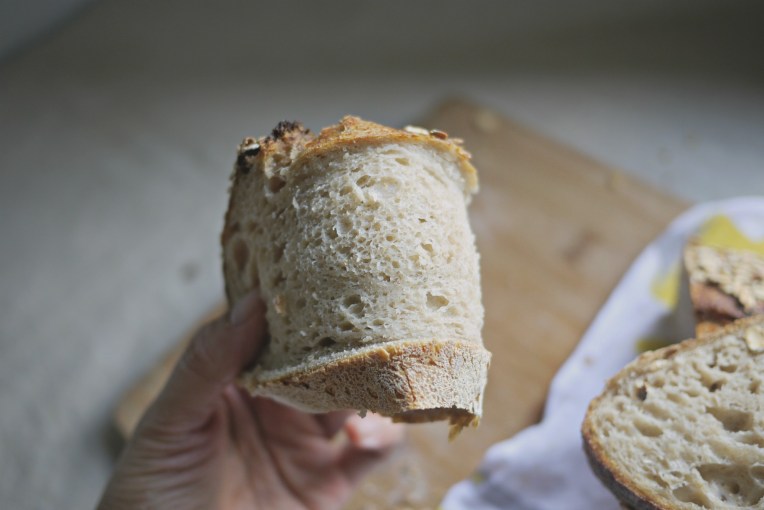
The “ugly” red dragon fruits my mom bought were unbelievably good-looking! According to her, fruit stores put up heavily discounted ugly or overripe fruit almost daily. My mom always buys the ones on clearance because they are such a steal; the red dragon fruits were going for $1 each that day.

The pink fruit makes great natural food colouring. Since I make bread every other day, the flesh of the fruit seems a good addition to my bread recipe.

I omitted eggs and milk to keep the recipe as basic as possible. The dough reached windowpane stage effortlessly and did a lovely bulk rise. After going through a second proofing, the bread looked very promising, tight gluten cloak and all.

Its bright pink hue turned into a pastel shade after baking but still pretty.

The crumbs are light and airy; not a dense loaf. Specks of seeds made the bread look even more wholesome!

My daughter, who normally doesn’t eat dragon fruits loves the pink bread slices. Now that’s a pretty way to add the fruit to her diet!
Red Dragon Fruit Bread Loaf
280g bread flour 130g red dragon fruit, mashed 1/2 teaspoon instant dry yeast 1/4 teaspoon sea salt 2 tablespoons raw sugar 30g water * 20g cold butter, cubed
* Do not pour all 30g water into the mixer bowl, add water bit by bit, watch the dough closely, stop once the ingredients form a rough ball.
In a mixer bowl, combine bread flour, red dragon fruit, instant yeast, sea salt, raw sugar, and water. Turn on the mixer with a dough hook attachment and knead these ingredients on the lowest speed (KA 1) till they come into a ball. Continue to knead for 3 minutes, then stop the mixer and let the dough sit for at least 15 minutes.
Turn on the mixer again and knead for 1 minute before adding butter cubes one by one while the mixer is running on its lowest speed. Keep kneading till there are no traces of butter left and the dough has reached windowpane stage. At this stage, the dough will be extremely pliable and baby-bottom soft.
Leave the dough in the mixer bowl for its first proof of 60 minutes. The dough will rise to double its volume, punch down to deflate and transfer it to a clean worktop.
Flatten the dough to push out gas trapped inside the dough, either by hand or a rolling pin. The dough is quite sticky, flour hands and worktop with flour to help with shaping. Shape the dough into a log and place it in a greased bread tin, seam side facing downwards. Let this sit in a draft-free place to rise for another 50-60 minutes. Optional: dust flour on bread top.
When the bread has risen to the rim of the baking tin, bake in a preheated oven at 170C for 30 minutes. Remove the bread from the pan immediately after baking, and let it cool on a rack completely before slicing or serving.
Store in an airtight container if not consumed immediately, to keep the loaf soft and the crumbs from drying out.























































